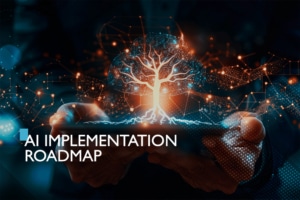AI Implementation Roadmap
for Southeast Wisconsin Businesses
Years in Business
Completed Projects
AI implementation roadmap development has become critical for businesses seeking competitive advantages in today’s rapidly evolving marketplace. Recent McKinsey research reveals that organizations following structured implementation plans achieve significantly higher success rates compared to those attempting ad-hoc deployments.
Companies investing in comprehensive AI deployment strategies report average returns of 3.7x on their investments, with financial services seeing even higher returns at 4.2x. However, the stark reality shows that 42% of organizations abandon their AI initiatives before reaching production, highlighting the importance of proper roadmap development.
The difference between successful and failed AI implementations often comes down to strategic planning and systematic execution. Southeast Wisconsin businesses face unique market conditions that require tailored approaches to technology adoption.
Manufacturing heritage, skilled workforce availability, and proximity to major metropolitan markets create distinct opportunities for AI integration. Understanding these regional dynamics while following proven implementation frameworks ensures maximum return on investment and sustainable competitive advantages.

The assessment process should examine existing business processes to identify automation opportunities that deliver immediate value. Milwaukee area businesses particularly benefit from evaluating repetitive tasks in manufacturing, customer service, and financial operations. Milwaukee Web Design has observed that companies conducting thorough readiness assessments achieve 40% higher implementation success rates than those skipping this crucial step.
Technical infrastructure evaluation must address computing resources, data storage capabilities, and integration requirements. Organizations need sufficient bandwidth and processing power to support AI workloads effectively. Additionally, data governance frameworks become essential for maintaining quality inputs that ensure accurate AI outputs and regulatory compliance throughout the deployment process.
Workforce readiness assessment identifies skill gaps and training requirements for successful adoption. Companies must evaluate current technical expertise while planning comprehensive education programs. This evaluation phase helps organizations understand whether they need external partnerships or can develop capabilities internally, directly impacting their Milwaukee AI deployment strategy.
Successful pilot project selection focuses on high-impact, low-risk use cases that demonstrate clear business value. Organizations should target processes with measurable outcomes, abundant data availability, and minimal operational disruption potential. Customer service automation, predictive maintenance, and financial forecasting represent ideal starting points for most Wisconsin businesses.
The pilot phase allows organizations to test their AI deployment strategy while building internal confidence and expertise. Companies report that well-executed pilots create momentum for broader organizational adoption. Research shows that 67% of businesses purchasing AI tools from specialized vendors achieve success, compared to only 33% attempting internal development from scratch.
Data collection and preparation during the pilot phase establishes foundational practices for larger implementations. Organizations must develop robust data governance procedures, quality control measures, and security protocols. These practices become increasingly important as companies scale their AI initiatives across multiple business functions and departments.
Success metrics definition ensures pilots deliver measurable results that justify continued investment. Companies should establish clear key performance indicators including productivity improvements, cost reductions, and accuracy gains. Generative Engine Optimization strategies help businesses measure and communicate these early wins to stakeholders and decision makers.
Scaling successful pilots requires systematic planning and phased rollout approaches that minimize operational disruption. Organizations must prioritize implementation across business functions based on potential impact, resource requirements, and strategic importance. McKinsey research indicates that companies establishing clearly defined roadmaps achieve significantly better results than those attempting simultaneous deployments.
Change management becomes critical during the scaling phase as organizations expand AI adoption beyond initial pilot groups. Companies must address employee concerns, provide comprehensive training, and demonstrate clear benefits to ensure widespread acceptance. Southeast Wisconsin businesses benefit from their strong manufacturing culture that emphasizes continuous improvement and process optimization.
Integration with existing business systems requires careful planning and technical expertise to ensure seamless operations. Organizations must consider data flow, workflow modifications, and user interface design to maximize adoption rates. Business scaling AI approaches help companies navigate these complex integration challenges while maintaining operational efficiency throughout the transition period.
Resource allocation during scaling requires balancing speed with sustainability to ensure long-term success. Companies must invest in technical infrastructure, employee training, and ongoing support systems. Organizations typically allocate 30-40% of their AI implementation budget to scaling activities, emphasizing the importance of proper financial planning and budget management.

Data privacy and security considerations become increasingly important as AI systems access sensitive business and customer information. Companies must implement robust cybersecurity measures, access controls, and monitoring systems. Wisconsin businesses particularly benefit from establishing clear data governance policies that comply with both federal and state regulations.
Algorithmic transparency and explainability help organizations build trust with customers and stakeholders while ensuring ethical AI deployment. Companies should document decision-making processes, maintain audit trails, and establish review procedures for AI-generated outputs. Southeast Wisconsin AI ethics considerations help businesses navigate these complex challenges responsibly.
Regulatory compliance requires ongoing monitoring and adaptation as AI governance frameworks continue evolving. Organizations must stay informed about changing requirements while maintaining flexible systems that adapt to new regulations. This proactive approach protects companies from compliance issues while ensuring sustainable long-term AI deployment strategies.
Continuous monitoring ensures AI systems maintain optimal performance while delivering expected business results. Organizations must establish real-time monitoring systems that track accuracy, efficiency, and user satisfaction metrics. Companies implementing comprehensive monitoring achieve 35% better long-term results than those relying on periodic assessments alone.
Performance optimization requires ongoing analysis and system adjustments to maintain competitive advantages. AI systems need regular updates, retraining, and fine-tuning to adapt to changing business conditions. leading research organizations emphasize that successful companies treat AI implementation as an iterative process rather than a one-time project.
Employee feedback collection helps organizations identify improvement opportunities and address adoption challenges. Companies should establish regular review processes that gather input from users across all business functions. This feedback loop enables continuous refinement of AI systems while building stronger organizational support for ongoing initiatives.
ROI measurement and reporting demonstrate the business value of AI investments while informing future strategic decisions. Organizations must track both quantitative metrics like cost savings and productivity gains, alongside qualitative benefits such as improved customer satisfaction. These measurements help justify continued investment while guiding expansion into new business areas and applications.
An AI implementation roadmap is a strategic plan that outlines the step-by-step process for deploying artificial intelligence solutions across business operations. It includes assessment phases, pilot projects, scaling strategies, and success metrics to ensure maximum ROI.
AI implementation timelines vary by complexity, but most successful deployments take 6-18 months from planning to full rollout. Organizations typically see initial ROI within 90 days of deployment when following a structured roadmap.
Companies implementing AI solutions see an average ROI of 3.7x their investment. Financial services companies achieve even higher returns at 4.2x, while 73% of Wisconsin businesses report positive ROI within the first year.
The primary challenges include poor data quality (85% of organizations), lack of clear business objectives, insufficient technical talent, and inadequate change management. However, 67% success rates are achieved when working with specialized AI vendors.
Successful implementations focus on data governance, phased rollouts, employee training, and clear ROI metrics. Starting with pilot projects and partnering with experienced vendors reduces failure rates significantly.
Web services are more than just website creation. They involve strategically crafting an experience that engages users, builds credibility, and turns your target audience into loyal customers.
Marketing goes beyond promoting products—it’s about telling a powerful brand story that builds trust, nurtures community, and drives meaningful business growth.
Book your no-obligation strategy session today and receive a complimentary custom homepage design. Limited to just 5 spots per month—reserve yours before they’re gone.

